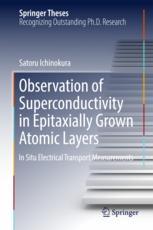

Most ebook files are in PDF format, so you can easily read them using various software such as Foxit Reader or directly on the Google Chrome browser.
Some ebook files are released by publishers in other formats such as .awz, .mobi, .epub, .fb2, etc. You may need to install specific software to read these formats on mobile/PC, such as Calibre.
Please read the tutorial at this link: https://ebookbell.com/faq
We offer FREE conversion to the popular formats you request; however, this may take some time. Therefore, right after payment, please email us, and we will try to provide the service as quickly as possible.
For some exceptional file formats or broken links (if any), please refrain from opening any disputes. Instead, email us first, and we will try to assist within a maximum of 6 hours.
EbookBell Team

4.4
22 reviewsThis thesis presents first observations of superconductivity in one- or two-atomic-scale thin layer materials. The thesis begins with a historical overview of superconductivity and the electronic structure of two-dimensional materials, and mentions that these key ingredients lead to the possibility of the two-dimensional superconductor with high phase-transition temperature and critical magnetic field. Thereafter, the thesis moves its focus onto the implemented experiments, in which mainly two different materials thallium-deposited silicon surfaces and metal-intercalated bilayer graphenes, are used. The study of the first material is the first experimental demonstration of both a gigantic Rashba effect and superconductivity in the materials supposed to be superconductors without spatial inversion symmetry. The study of the latter material is relevant to superconductivity in a bilayer graphene, which was a big experimental challenge for a decade, and has been first achieved by the author.
The description of the generic and innovative measurement technique, highly effective in probing electric resistivity of ultra-thin materials unstable in an ambient environment, makes this thesis a valuable source for researchers not only in surface physics but also in nano-materials science and other condensed-matter physics.